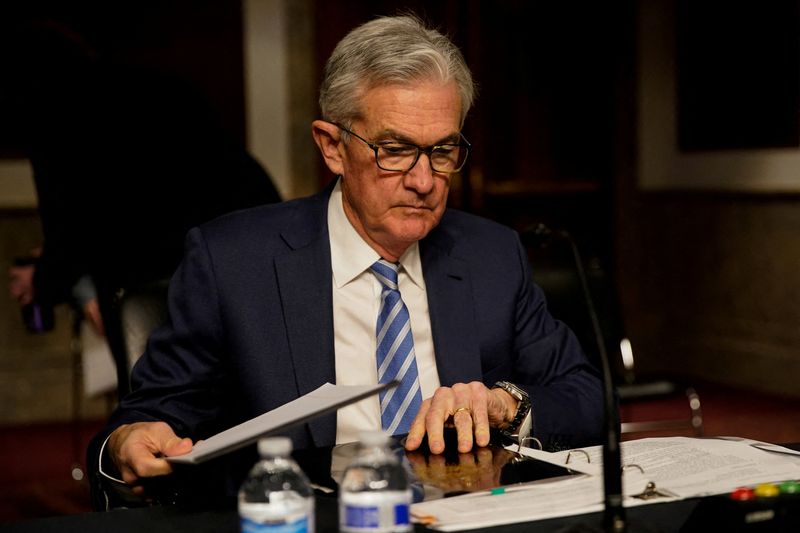By Lindsay (NYSE:LNN) Dunsmuir
(Reuters) - The U.S. Federal Reserve, stung by persistently high inflation and encouraged by lower-than-expected unemployment, is set on Wednesday to chart a path of higher interest rates next year as policymakers show their hands on just how soon and how much they think borrowing costs will need to increase to keep the economy on an even keel.
Fed Chair Jerome Powell has already flagged the rate-setting committee will likely announce at its policy meeting this week that it will accelerate the end of its bond-buying program, wrapping it up by March instead of June, in order to clear the way for the Fed to lift off interest rates from near zero, where they have been held since March 2020 when the coronavirus pandemic triggered a short but deep recession.
The sharp turn in rhetoric as the central bank plots its course out of emergency era measures reflects the depth of unease over how the COVID-19 pandemic has juiced demand, played havoc with supply chains and led to broader and more persistent inflation that risks becoming embedded in business and consumer expectations.
It will lead to policymakers' bringing forward their projections for interest rate rises, in their so-called "dot plot," as part of their forecasts, released quarterly, for economic growth, employment and inflation as well as the timing of interest rate rises.
"The Fed needs to be a bit more aggressive with removing accommodation than they have been," said Tim Duy, chief U.S. economist at SGH Macro Advisors, who expects officials to revise their median forecast to two rate hikes next year to rein in inflation levels, from a split at their last meeting on if they even needed one.
Graphic: The Fed's inflation outlook - https://graphics.reuters.com/USA-FED/INFLATION/gkvlgxyqnpb/chart.png
Most analysts expect the Fed to stick to forecasting three rate hikes in 2023 and 2024, given officials still expect a rapid abatement of price pressures in the latter half of next year as the pandemic recedes from view.
For now, U.S. consumer price increases remain eye-watering. They increased further in November, leading to the largest annual gain, at 6.8%, since 1982, Labor Department data showed on Friday, and well above the central bank's 2% flexible average goal.
The impact of the Omicron variant may also keep inflation pressures elevated by prolonging supply chain issues and exacerbating labor shortages while doing less damage to economic growth than previous waves.
How soon the Fed actually starts liftoff is less certain. Economists polled by Reuters expect the Fed to raise interest rates in the third quarter of next year, but as with other analysts, also note the risk is a hike comes sooner.
Inflation is not expected to peak until March next year, just when the Fed will likely have finished its bond taper, making it harder for officials to communicate a more patient course.
Investors currently see a greater-than 50% probability that the Fed will raise its benchmark overnight lending rate in May, according to CME Group's (NASDAQ:CME) FedWatch tool.
In addition to the dots, investors would be wise to scrutinize Powell, who has taken a more emboldened stance in shifting the Fed's consensus, for his perception of the outlook next year.
"If Powell is in the camp of two rate hikes next year, that's a fairly strong indication that you'll get rate liftoff in the middle of next year," said Gregory Daco, chief U.S. economist at Oxford Economics.
Graphic: A faster taper plan at the Fed? - https://graphics.reuters.com/USA-FED/akpezmwejvr/chart.png
UNEMPLOYMENT RATE HELPS SEAL THE DEAL
What no longer appears to be hampering the Fed's tightening of policy is the pace of job gains, with the central bank on track to meet its maximum employment goal by the middle of next year.
The unemployment rate fell to 4.2% in November, far below the Fed's estimate in September of 4.8% for year end. Officials will tweak their unemployment estimates downward for this year and next. Their economic growth forecasts, set to be revised down slightly this year, may remain mostly intact.
What the Fed is aiming to do is keep their hiking path gradual after liftoff in order to not choke off the labor market recovery and encourage continued improvement in the labor force participation rate, economists at Morgan Stanley (NYSE:MS) wrote in a note to clients. A key gauge of the job market's health watched closely by policymakers, the rate is 61.8%, still about 1.5 percentage points below where it was right before the pandemic and showing only modest signs of improvement.
A gradual course of interest rate increases would allow the Fed to claim it is prioritizing price stability but not at the expense of the broad and inclusive employment goal it has championed.

But as with any forecast, reality may once again blow the Fed off course, as both it and the world awaits news of the severity and contagiousness of the Omicron variant, which is already complicating hopes for a smoother path ahead next year and increasing financial market volatility.
"The uncertainty to the outlook has increased," said Daco. "That will be a feature of next year's environment where you have less certainty as to what monetary policy will be and less certainty to what the economic outlook is going to be."